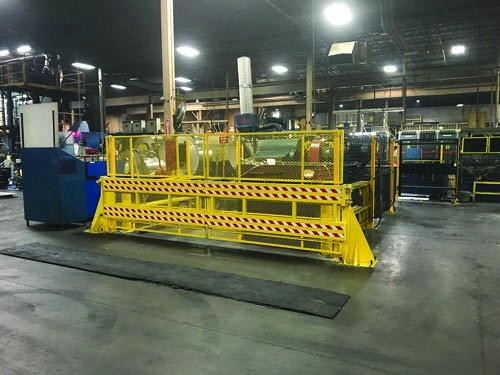Making the case for physical barriers
Why are physical barriers crucial to plant safety?

Responding is Nikkie Chambers, designer and marketing representative, US Netting, Erie, PA.
Manufacturing facilities are staples worldwide. They produce items we use every day, employ millions of workers, and typically use a variety of large and dangerous equipment.
Although safety standards and regulations are in place and inspections are conducted often, incidents and injuries happen. One of the most effective ways to prevent them is the use of physical barriers.
A physical barrier is anything that will stop an object in motion. Chains, nets, gates, walls, guardrails and fencing are all examples of physical barriers, and each comes with its own set of capabilities and effectiveness.
For example, a chain is better for temporarily closing areas for cleaning or maintenance, while a gate or net is better suited for an area needing a more permanent solution, such as around machinery.
Manufacturing environments almost always house machinery, which can be part of an assembly line or operate independently. These machines have many moving parts and are hazardous, even if nothing goes wrong. And if something does, they can be deadly.
In an unprotected area, an employee walking by could have an article of clothing snagged by a robotic arm, pulling him or her into the machine; a cable could snap and go whipping through the air, striking anything or anyone in its path; or oil could leak onto the floor, causing a worker to slip and fall. We don’t expect these types of events to occur, but we can do our best to plan for them.
These areas should be wholly barricaded and inaccessible to those who don’t have a reason to be there or may accidentally stumble into them. You can do this by installing netting around the perimeter and ensuring the entirety of the danger zone is within those boundaries. If necessary, barriers with locks can be placed at an entrance for workers who may need to gain access.
Physical barriers are essential in areas where people work near forklifts. If either worker or driver isn’t paying attention, it could lead to a struck-by incident.
Many plants choose to use floor tape and warning signs to indicate danger zones, but these aren’t enough. We often overlook aspects of our surroundings once we’ve become familiar with them. Our attentiveness fades, we become robotic in our daily movements and we’re no longer “on our toes.” Installing barriers that will ultimately separate individuals from vehicles will prevent them from unexpectedly encountering one another. But, if that isn’t possible, many barriers function as crossing gates, drawing attention to the dangers present.
Physical barriers also play a vital role in preventing falls. Loading docks, ramps, stairs, upper levels, and hatches or skylights are all places that require barriers. Hatches and skylights need guardrails or netting – or both – while gates, guardrails or netting are necessary in other areas. Chains can provide additional security, but aren’t enough on their own to prevent an individual from falling.
Most incidents that occur in a manufacturing facility are entirely preventable. Installing and using physical barriers has profound effects on the safety of you, your employees, your product and your bottom line.
Editor's note: This article represents the independent views of the author and should not be construed as a National Safety Council endorsement.
Post a comment to this article
Safety+Health welcomes comments that promote respectful dialogue. Please stay on topic. Comments that contain personal attacks, profanity or abusive language – or those aggressively promoting products or services – will be removed. We reserve the right to determine which comments violate our comment policy. (Anonymous comments are welcome; merely skip the “name” field in the comment box. An email address is required but will not be included with your comment.)

